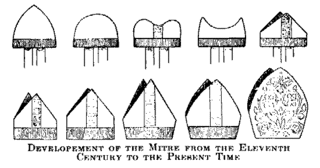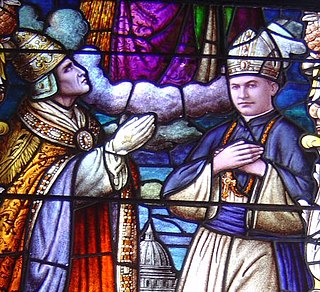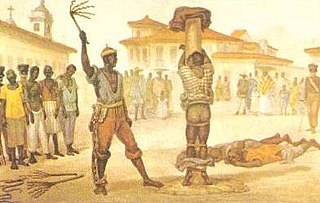Canon law is a set of ordinances and regulations made by ecclesiastical authority, for the government of a Christian organization or church and its members. It is the internal ecclesiastical law, or operational policy, governing the Catholic Church, the Eastern Orthodox and Oriental Orthodox churches, and the individual national churches within the Anglican Communion. The way that such church law is legislated, interpreted and at times adjudicated varies widely among these three bodies of churches. In all three traditions, a canon was originally a rule adopted by a church council; these canons formed the foundation of canon law.

An episcopal polity is a hierarchical form of church governance in which the chief local authorities are called bishops. It is the structure used by many of the major Christian Churches and denominations, such as the Roman Catholic, Eastern Orthodox, Oriental Orthodox, Church of the East, Anglican, and Lutheran churches or denominations, and other churches founded independently from these lineages.

The word diocese is derived from the Greek term dioikesis (διοίκησις) meaning "administration". Today, when used in an ecclesiastical sense, it refers to the ecclesiastical district under the jurisdiction of a bishop.

A crosier is a stylized staff carried by high-ranking Roman Catholic, Eastern Catholic, Eastern Orthodox, Oriental Orthodox, Anglican, and some Lutheran, United Methodist and Pentecostal prelates. Other typical insignia of many of these prelates are the mitre, the pectoral cross, and the episcopal ring. A crosier staff is a part of the tradition of Jewish Christianity.

An episcopal see is, in the usual meaning of the phrase, the area of a bishop's ecclesiastical jurisdiction.
A sexton is an officer of a church, congregation, or synagogue charged with the maintenance of its buildings and/or the surrounding graveyard. In smaller places of worship, this office is often combined with that of verger. In larger buildings, such as cathedrals, a team of sextons may be employed.

A sacristy is a room for keeping vestments and other church furnishings, sacred vessels, and parish records. In some countries, it is known as the vestry.

A chimere is a garment worn by Anglican bishops in choir dress, and, formally as part of academic dress.

The title archimandrite, primarily used in the Eastern Orthodox and the Eastern Catholic churches, originally referred to a superior abbot (hegumenos) whom a bishop appointed to supervise several 'ordinary' abbots and monasteries, or to the abbot of some especially great and important monastery.

A sacristan is an officer charged with care of the sacristy, the church, and their contents.

The Cathedral Church of Saint Matthew, known simply as St. Matthew's Cathedral, is an Episcopal cathedral church located at 5100 Ross Avenue in Dallas, Texas, in the United States.
Ecclesiastical polity is the operational and governance structure of a church or of a Christian denomination. It also denotes the ministerial structure of a church and the authority relationships between churches. Polity relates closely to ecclesiology, the study of doctrine and theology relating to church organization.
The Hymnal 1982 is the hymnal of the Episcopal Church in the United States of America. It is one in a series of 7 official hymnals of the Episcopal Church, including The Hymnal 1940. Unlike many Anglican churches the Episcopal Church requires that the words of hymns be from officially approved sources, making the official hymnals perhaps more important than their counterparts elsewhere. The Hymnal 1940 was originally compiled with input from the Joint Commission on Church Music of the Episcopal Church, which was founded in 1919. The Hymnal 1982 was put together based on the Joint Commission's work by the Standing Commission on Church Music. The Hymnal 1982 had a much expanded service music and chant section, which became necessary with the introduction of the 1979 Book of Common Prayer. The Hymnal 1982 was approved by both houses of General Convention, the governing body of the Episcopal Church, in 1982. It is published by The Church Pension Fund.
The Bishop of Maidstone is an episcopal title used by a suffragan bishop of the Church of England Diocese of Canterbury, in the Province of Canterbury, England. The title takes its name after the county town of Maidstone in Kent and had a similar though subordinate role to that of the Bishop of Dover. It was decided at the diocesan synod of November 2010 that a new bishop would not be appointed.

Christ Church Cathedral is the cathedral for the Episcopal Diocese of Indianapolis. Christ Church parish was formally organized in 1837. The present-day church building was erected in 1857 on Monument Circle at the center of downtown Indianapolis to replace the parish's first church built on the same site. Designed by architect William Tinsley, the English Gothic Revival-style structure is the oldest church building in Indianapolis and Marion County, Indiana, that has remained in continuous use. It is also the oldest building on Monument Circle. Christ Church is known for its music, especially its pipe organs, one of which was donated by Ruth Lilly, and its professional Choir of Men and Boys and Girls' Choir. The parish is also known for its community service, including an annual strawberry festival fundraiser and other charitable work. Christ Church Cathedral was added to the National Register of Historic Places on July 10, 1973. It is located in the Washington Street-Monument Circle Historic District.

The Episcopal Church (TEC) is a member church of the worldwide Anglican Communion based in the United States with dioceses elsewhere. It is a mainline Christian denomination divided into nine provinces. The presiding bishop of the Episcopal Church is Michael Bruce Curry, the first African-American bishop to serve in that position.
Brazilians in Nigeria consist mostly of descendants of freed Afro-Brazilian slaves who left Brazil and settled in Nigeria as well as expatriates from Brazil.













